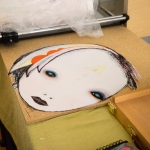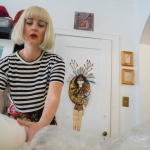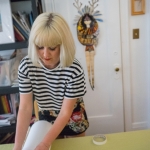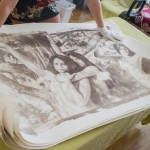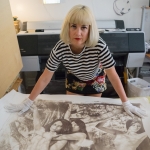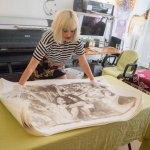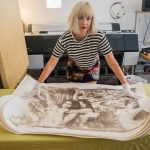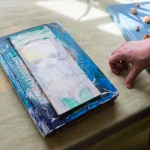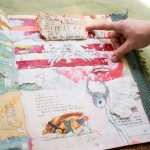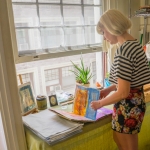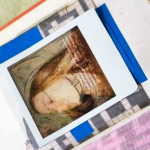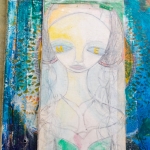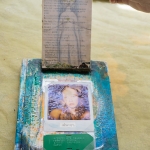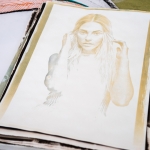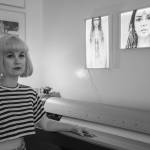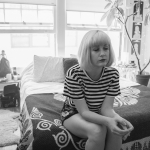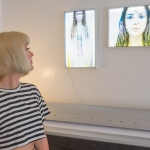Teresa Flowers lives life with the utmost inventiveness. After leaving Salt Lake, Utah, Flowers is finding her big-city footing within the local arts scene in sunny Los Angeles. With an appreciation for both old and new-age photography, Flowers has honed a unique craft adopting several techniques and compiling them for multidimensional flair. Rather than settling on one medium, Flowers layers her skills to create unique large-scale pieces. Underneath colorful paint and sketches, old and new photographs are given new meanings—it’s not just about the images, but the psychedelic energy they posses.
Flowers’ latest project, a two-year work in progress titled Echoes, is an ode to her original take on alternative photography. Incorporating lights, photographs, drawings, paint and her Flowers-y edge, the ongoing project – her psychedelic baby of sorts – is about to blow up the LA arts scene.
You have quite a following. You’ve been in Utah for a very long time. What’s it been like coming to a new place like Los Angeles and trying to build a new reputation?
It’s hard. It’s really hard actually, and at the same time I’m still that person from Utah. You know when I go to meet somebody I know what I’ve done. I feel like when I talk to people they are interested because I have a lot of passion about what I do and I think people appreciate that. It’s just a matter of time for things to start happening.
In Utah it took five, ten years for people to know whom I was. So I know it’s going to take time here. The reason why my most recent project, which I have been working on for about four years, has been on hold is because I don’t have a place to show it. I need to be able to make enough money to finish this project. And to make money I need to have people care about what I’m doing here, and in order to do that, there’s like a series of steps that need to happen to create the project. It takes time.
Tell me more about this project.
I produced sixty albumen prints. An albumen print is from the turn of the century, and it’s the kind of process where you actually wipe the emulsion on to watercolor paper. Then it dries and you contact print it, then put it in the sun and that’s how it develops. My albumen prints are 24×30 inches – as far as I know they’re the largest albumen prints that have ever been produced. It takes hundreds of dollars just to make one of them. I made sixty of them; three years to shoot it, six months to gather the supplies and enough money to make it. Now I have them so I’m at the paint and drawing steps.
We definitely saw your process video about this. Is this part of the Echoes series?
The video you saw is the Echoes installation. These are the pieces that will go on the wall that are not in the video. They are on my Instagram, so if you go on my Instagram you would’ve seen some of their images in the process.
What inspired you to do this project?
Fifteen years ago people didn’t respect photography and people didn’t get how you could combine painting and drawing with the medium. Photography is very much about rules and structure and putting things a certain way, very linear to a certain extent. But I started and continued to always be fascinated about drawing and painting on photographs. People never respected me for it, but it was just something for fun. I would take magazines and draw and paint on them so I’ve been doing it for a long time.
Until four years ago I was taking old antique photos and I was drawing on them. That was the first start of the Echoes series, starting in my head. It was about both of my parents who have passed on. I’ve always wondered, am I going to see them again? You kind of meet people who you have this connection with, like did I know you in some other time or space? My parents have both passed away so I sometimes wonder if I’ll ever see them again. This is what sort of started my idea. Everyone’s a photographer and everyone’s doing photography. I decided I’m going to start doing my painting in a serious way – I missed it. I was looking for an alternative process, using watercolor on paper. That’s how it all started.
What do you like about combining mediums?
I love layering. I love little hints of things that are underneath something else. You add to them and make them something else. With the Echoes series I actually layered glass negatives with my drawing and paintings so they would become multidimensional. It almost looks like it’s alive. They look like they’re looking at you no matter where you stand in relation to the them; they take on this completely new form.
I’ve been working on the Echoes pieces now for two years and I’m kind of seeing that I’m not the only one that is thinking about these things and I can see that people are questioning the same ideas about photography that I am. Echoes is about reincarnation and about wondering if time and space, if it’s not linear, then how is it happening right now? It’s very psychedelic and calls for having an open mind.
So you’ve definitely seen people really starting to push the boundaries of normative photography. You seem to be pushing them quite a bit yourself.
You know I have a little bit. I went to Paris Photo at the Paramount Studio and it was so cool to see what was happening in contemporary photography, but I didn’t see anyone working in the way that I work. I didn’t see very many layers – paint and drawing on images. The biggest issue I run into is when I approach galleries and they’re like, “oh we don’t do photography,” or “oh we don’t do painting and drawing.” My work is very much an incorporation of both. It’s not one or the other. Painting and drawing on photos is starting to become more accepted but it’s still on the edge. Photography is still a little stuck in the past.
Do you find that’s the biggest challenge, finding somewhere to exhibit your work especially your newer pieces?
Yes definitely, I feel like people like me when they meet me, but they still don’t know me yet. It’s hard for people to know unless they see it in real life, so they need to come to my studio. I’m putting myself out there, but I’m not known in the greater world. I’ve been published in a bunch of different things, but life in Salt Lake… it’s kind of like life under a rock.
It’s just a matter of time.
I imagine life is much different here in LA, what do you love about each city, Salt Lake City and LA?
Salt lake is so great. My life was so great there. It’s really, really beautiful. The natural beauty is endless. When I lived in Salt Lake I was a teacher at a university and I could ride my bike anywhere I wanted to go because I’m an avid cyclist. It’s an important activity to me. It’s been a total shock moving to LA, because LA drivers are complete assholes. I almost get killed every time I get on my bike. I’m getting used to it though.
What I love about LA is all the cool stuff that’s going on all the time. I got to meet Alex Gray and Shepherd Fairy not too long ago; I would never get to meet them in Salt Lake City. I love that I’m in a place where my talents and suggestions can be seen and heard in a bigger way. Salt Lake was very supportive, my community loved me, but it wasn’t financially supportive. Here I’m hoping that my vision and my dreams can remain really big and also be supported.
Los Angeles is a place where making a career is a reality. People in LA are supported; if I was in Salt Lake I wouldn’t be getting the [financial] support I need. There is so much competition here, so it’s definitely not easy, but I like the challenge. I feel like I’m good enough to compete with those people, that’s why I moved here and at the same time it’s very humbling. Sometimes it’s like, “who the fuck are you and what are you doing here?”
I know you shoot some fashion photography as well, but tell me about your favorite style?
I love shooting nudes. I started shooting nudes when people still weren’t doing that in photography. It was all totally taboo. I remember in Salt Lake it was like, “Why are you photographing nude people,” people were really weirded out by it. But with my work now people are really starting to get it. My work is very edgy. I have a lot to say when I’m doing photography. It was a way for me to get through some of the stuff I was going through in my life. I straight up love fashion, and I love tall alien looking girls.
When did you first pick up the camera?
I picked up the camera when my mom was really sick. My mom had AIDS, and I couldn’t tell anyone about it because we would get a huge backlash. We got kicked out of our house so I had to keep it a secret for a few months before my mom passed on. Photography was a way for me to express what was going on. It has become a lot lighter now, but there are still daily challenges.
It’s hard to trudge on after such losses.
It is and I’m very strong. I had my personality read by like a face reader and she said, “You are a finisher; you always finish what you start.” I couldn’t believe it, that is so true. I do not give up. Being an artist is not easy especially doing something that people don’t always get. I feel like art has been that vehicle to keep going. There are a lot of artists who care more about the process or saying something about the world. My work is mostly about my experience, it’s very emotional.
For more from Teresa Flowers, visit www.teresaflowers.com and www.sleepictures.com; or on her instagram: @teresaflowers
Photographs by our dear friend and talented photographer Chelsea Cody.


